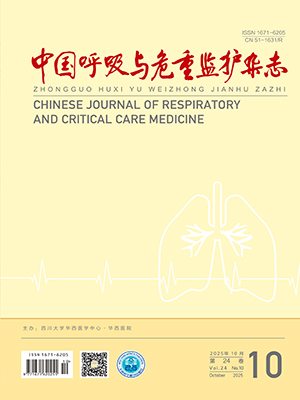| 1. |
Siegel RL, Giaquinto AN, Jemal A. Cancer statistics, 2024. CA Cancer J Clin, 2024, 74(1): 12-49.
|
| 2. |
Planchard D, Jänne PA, Cheng Y, et al. Osimertinib with or without chemotherapy in EGFR-mutated advanced NSCLC. N Engl J Med, 2023, 389(21): 1935-1948.
|
| 3. |
Shaw AT, Bauer TM, De Marinis F, et al. First-line lorlatinib or crizotinib in advanced ALK-positive lung cancer. N Engl J Med, 2020, 383(21): 2018-2029.
|
| 4. |
Krishnamurti U, Silverman JF. HER2 in breast cancer: a review and update. Adv Anat Pathol, 2014, 21(2): 100-107.
|
| 5. |
Mano MS, Rosa DD, De Azambuja E, et al. The 17q12-q21 amplicon: Her2 and topoisomerase-IIalpha and their importance to the biology of solid tumours. Cancer Treat Rev, 2007, 33(1): 64-77.
|
| 6. |
Kato Y, Udagawa H, Matsumoto S, et al. Efficacy of immune checkpoint inhibitors plus platinum-based chemotherapy as 1st line treatment for patients with non-small cell lung cancer harboring HER2 mutations: Results from LC-SCRUM-Asia. Lung Cancer, 2024, 197(107992.
|
| 7. |
Sompallae RR, Dundar B, Guseva NV, et al. EGFR and ERBB2 exon 20 insertion/duplication in advanced non-small cell lung cancer: genomic profiling and clinicopathologic features. Front Oncol, 2023, 13: 1163485.
|
| 8. |
NATIONAL COMPREHENSIVE CANCER NETWORK. NCCN Clinical Practice Guidelines in Oncology: Non-Small Cell Lung Cancer (Version 3.2025). NCCN; 2025. Available from: https://www.nccn.org/guidelines/guidelines-detail?category=1&id=1450.
|
| 9. |
Li BT, Smit EF, Goto Y, et al. Trastuzumab deruxtecan in HER2-mutant non-small-cell lung cancer. N Engl J Med, 2022, 386(3): 241-251.
|
| 10. |
Li B T, Michelini F, Misale S, et al. HER2-mediated internalization of cytotoxic agents in ERBB2 amplified or mutant lung cancers. Cancer Discov, 2020, 10(5): 674-687.
|
| 11. |
Ren S, Wang J, Ying J, et al. Consensus for HER2 alterations testing in non-small-cell lung cancer. ESMO open, 2022, 7(1): 100395.
|
| 12. |
Odintsov I, Makarem M, Nishino M, et al. Prevalence and therapeutic targeting of high-level ERBB2 amplification in NSCLC. J Thorac Oncol, 2024, 19(5): 732-748.
|
| 13. |
Cho B C, Kim DW, Spira A I, et al. Amivantamab plus lazertinib in osimertinib-relapsed EGFR-mutant advanced non-small cell lung cancer: a phase 1 trial. Nat Med, 2023, 29(10): 2577-2585.
|
| 14. |
Goto K, Goto Y, Kubo T, et al. Trastuzumab deruxtecan in patients with HER2-mutant metastatic non-small-cell lung cancer: primary results from the randomized, phase II DESTINY-Lung02 Trial. J Clin Oncol, 2023, 41(31): 4852-4863.
|
| 15. |
Gandhi L, Rodríguez-Abreu D, Gadgeel S, et al. Pembrolizumab plus chemotherapy in metastatic non-small-cell lung cancer. N Engl J Med, 2018, 378(22): 2078-2092.
|
| 16. |
Chen K, Pan G, Cheng G, et al. Immune microenvironment features and efficacy of PD-1/PD-L1 blockade in non-small cell lung cancer patients with EGFR or HER2 exon 20 insertions. Thorac Cancer, 2021, 12(2): 218-226.
|
| 17. |
Ho D, Imai K, King G, et al. MatchIt: nonparametric preprocessing for parametric causal inference. J Stat Softw, 2011, 42(8): 1-8.
|
| 18. |
Yang G, Tian L, Wang Y. Hyperprogressive disease induced by PD-1 inhibitor monotherapy in lung adenocarcinoma with HER2 exon 20 insertion: report of two cases and review of literature. Discov Oncol, 2025, 16(1): 12.
|
| 19. |
Miura A, Yamada D, Nakamura M, et al. Oncogenic potential of human pluripotent stem cell-derived lung organoids with HER2 overexpression. Int J Cancer, 2021, 149(8): 1593-1604.
|
| 20. |
Prelaj A, Bottiglieri A, Proto C, et al. Poziotinib for EGFR and HER2 exon 20 insertion mutation in advanced NSCLC: Results from the expanded access program. Eur J Cancer, 2021, 149: 235-248.
|
| 21. |
Liu Y, Yuan M, Wu C, et al. A comprehensive function analysis of LMO2 in different breast cancer subtypes. Oncotarget, 2018, 9(10): 8911-8926.
|
| 22. |
Xiang Z, Song S, Zhu Z, et al. LncRNAs GIHCG and SPINT1-AS1 are crucial factors for pan-cancer cells sensitivity to lapatinib. Front Genet, 2019, 10: 25.
|
| 23. |
Xia L, Yu Y, Lan F, et al. Case report: tumor microenvironment characteristics in a patient with HER2 mutant lung squamous cell carcinoma harboring high PD-L1 expression who presented hyperprogressive disease. Front Oncol, 2021, 11: 760703.
|
| 24. |
Yang M, Xu X, Cai J, et al. NSCLC harboring EGFR exon-20 insertions after the regulatory C-helix of kinase domain responds poorly to known EGFR inhibitors. Int J Cancer, 2016, 139(1): 171-176.
|
| 25. |
Song Z, Wang M, Ge Y, et al. Tyrosine phosphatase SHP2 inhibitors in tumor-targeted therapies. Acta Pharm Sin B, 2021, 11(1): 13-29.
|
| 26. |
Liu S Y, Erazo T, Jee J, et al. Optimal systemic treatment and real-world clinical application of ctDNA in patients with metastatic HER2-mutant lung cancer. Eur J Cancer, 2024, 210: 114257.
|
| 27. |
Zhao S, Xian X, Tian P, et al. Efficacy of combination chemo-immunotherapy as a first-line treatment for advanced non-small-cell lung cancer patients with HER2 alterations: a case series. Front Oncol, 2021, 11: 633522.
|
| 28. |
Yamaguchi T, Shimizu J, Matsuzawa R, et al. Efficacy of chemotherapy plus immune checkpoint inhibitors in patients with non-small cell lung cancer who have rare oncogenic driver mutations: a retrospective analysis. BMC Cancer, 2024, 24(1): 842.
|




